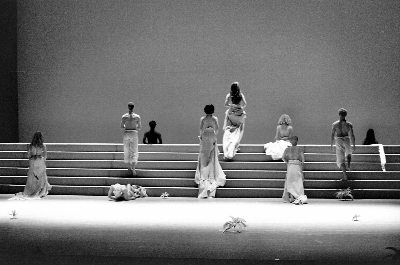Lincoln Center’s annual summer presentations include innovative dance
For a third consecutive season, the New York-based Shen Wei Dance Arts brought uniquely modern choreography to the annual Lincoln Center Festival of performing arts.
The world premiere of “Map” was the featured piece at the New York State Theater last weekend. On opening night, the program began with “Near the Terrace, Part I,” from 2000, never before seen in New York.
Created for the American Dance Festival, the piece is inspired by the paintings of Belgian surrealist Paul Delvaux. Its very slow movement and statuesque poses recall Shen’s “Folding,” seen at the 2003 Lincoln Center Festival. But the similarities end there.
In “Near,” diminutive palms dot the stage in the foreground and an upstage set piece undoubtedly represents the terraced farmland of Shen’s native China.
To the gorgeous “Fur Alina” and “Spiegel im Spiegel” from Arvo Part’s “Alina,” the group makes slow trajectories up and down the stage, some rest on and blend into the terrace. Nude Kennis Hawkins strides across the top against a horizon streaked with pink. Jessica Harris’s perfunctory solo walk contrasts with the slow tempo, a languid cartwheel and frictionless spins. Among the barely noticeable dwarfed trees, all the dancers are lying about or sitting when several abruptly shoot over into the nearest lap. Everything is powdered with white fallout, including the beautifully bare-breasted dancers, though Sara Procopio’s black hair and Hou Ying’s dark eyes are spared. Sadira Smith’s dark brown figure becomes a focal point as she turns almost imperceptibly toward the audience and later descends the terraced incline in an outsized red hat.
No one but Shen accomplishes this slowness with such authority, except maybe Arvo Part.
The end offers an understated but welcome climax. The poignant “Near the Terrace, Part I” evinces the slow passage of time in work and love, in a cold dry environment where life is stunted. Does Shen use his dancers to celebrate, possibly exploiting darkness as a vessel of deep rich life, and white as its absence? Some might find this idealized typecast problematic.
“Map” has neither the preciousness of Shen’s signature works nor his touted East-West fusion. The East has virtually disappeared in this topography of American pop culture. The program notes explain the elaborate structuring of “Map” to Steve Reich’s “The Desert Music.” The backdrop is a blackboard drawing of scribbled equations in red, yellow and blue chalk—Basquiat meets John Nash.
The costumes, also of Shen’s design, are jeans with tie-died T-shirt or tank tops. The dancers groove in unison with bouncy, convulsive isolations and rotations. In later sections of the dance, they are more angular and straight but still very fluid. They often separate into opposing camps that never confront each other aggressively. Solos shoot off, and watching one or another of these exquisite dancers, in movement that is as playful as it is virtuosic, can be engaging in itself.
Three mop-headed women tumble in a loose ball toward the side of the stage in measured increments; their raised rumps alternate in a moving ridgeline formation. These are wired young people, like schools of mall rats. A dozen or more swarm the stage, and with an identically raised arm and a flattened, beakish hand, they steer the group in swaying waves that create morphing curved shapes. In this section, Shen approaches the sense of ‘losing oneself’ that Reich was after in “The Desert Music.”
Fans of Reich’s repetitive music will enjoy Shen’s reiteration of that, and his literal transposing of its structure; the jazzy loose swinging arms make a nice counterpoint.
“Map” employs a deceptively popular aesthetic, but is operatic in length; and this will not ensure its popularity. Shen’s mapping of the music with an idiosyncratic, almost utopian movement vocabulary is characteristic of his work, and also very contemporary. “Map” is in keeping with Shen’s creative analysis of Stravinsky’s “Rite of Spring,” and includes a section of unsettling chaos as in last year’s “Connect/Transfer.” The dancing is refreshingly twisted, casual and naïve for Shen, but feels as 1984 as the music.
gaycitynews.com


































